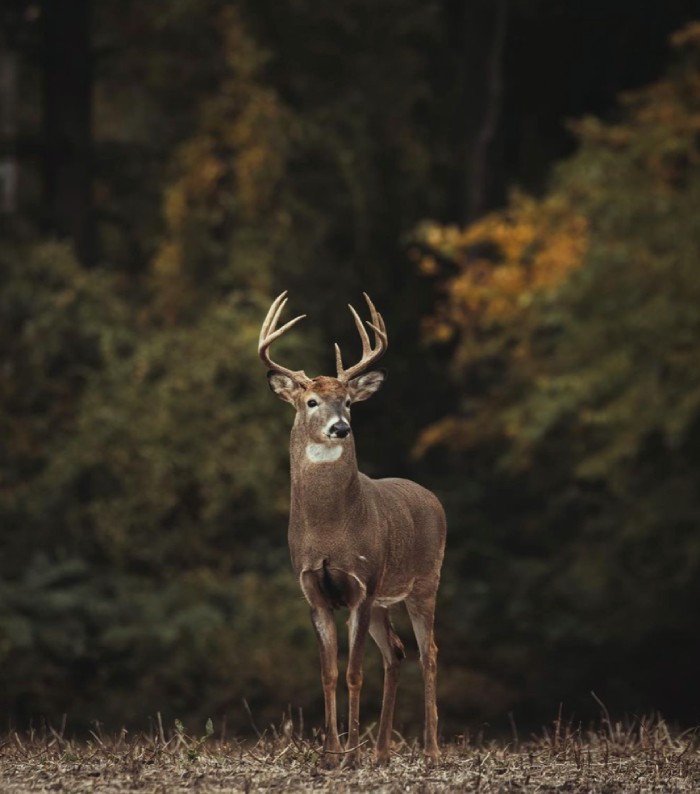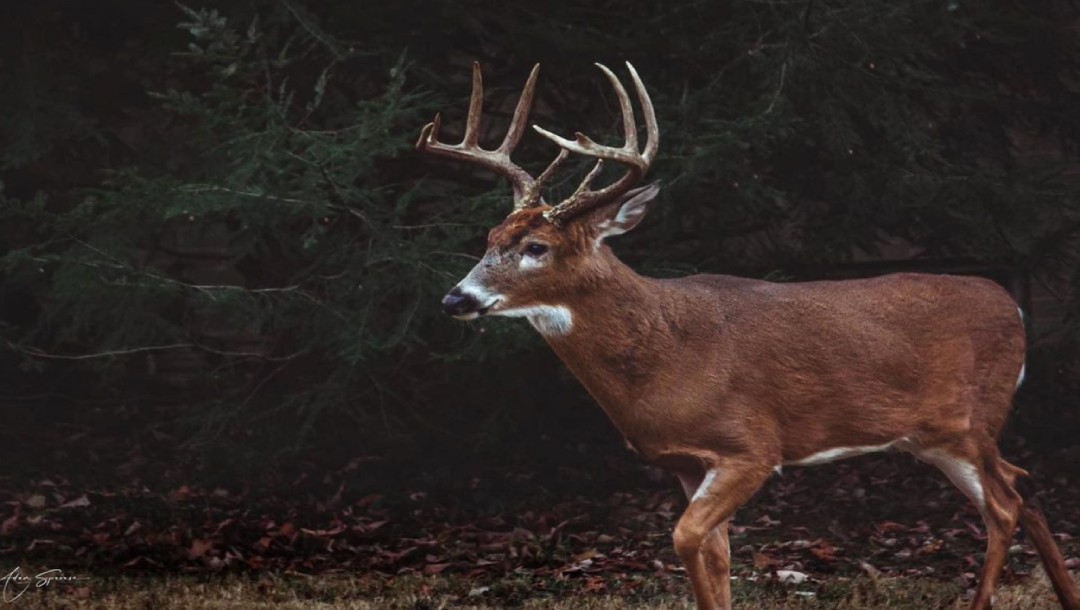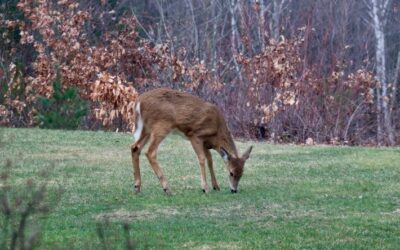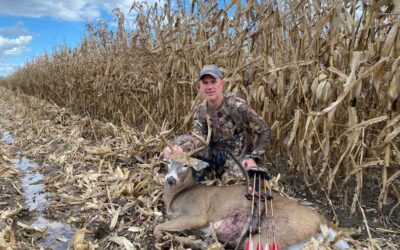When trying to rattle in whitetail bucks, you want to create the most realistic sounds. It can be a challenge to create a good illusion of two bucks fighting over a hot doe. However, this article will cover everything you need to know to rattle in whitetail bucks effectively.
Even if you are a beginner and this is your first time trying to rattle in whitetail bucks, after reading this you will be well equipped to get in the woods and rattle in your first buck.
Rattling Whitetail Deer Based on Age Class
Whether you have experience rattling in whitetail bucks or not, you want to understand how to rattle and call bucks based on their age class.
Tip #1: The age class of the whitetail deer that you are trying to rattle in will ultimately determine how you structure your rattling sequence, volume (or aggressiveness), and the amount of rattling.
Mature Older Whitetail Bucks
Whitetail deer as a species are dominant animals. Their nature is to breed as many hot do as they can.
Bucks will accomplish this by dominating a resource-rich area. Resource-rich meaning that there is a good food source, water, and heavy cover. (All things that deer need to survive and thrive.)
If you know a dominant buck that is, let’s say 6 years old, in the area, you want to rattle much differently than trying to rattlin in a whitetail buck that is 3 years old.
Big bucks will be much less likely to be scared off by a mature rattling sequence or calling sequence.
This allows you the ability to use your rattling antlers or rattle bag much more aggressively. The more aggressive that you rattle like a buck fight, the young buck will become less interested due to fear of being beat by a more mature buck and just avoid the situation.
But, that mature buck you are chasing, he will think that another older buck has come into his area and is breeding another hot doe.
This will draw him into bow range so you can make a lethal shot.
Tip #2: Old bucks want to assert dominance. Rattling in Whitetail Bucks that are mature requires you to act as if another buck is challenging his core area.
Rattling in Young Whitetail Bucks
Young whitetail bucks are often more curious than mature bucks when it comes to fighting with other bucks. This is because they are just starting to understand how the dominance hierarchy works and where they fit in.
If you are trying to rattle in a young whitetail buck, you do not want to be ultra-aggressive. Rather, an average level of aggression will interest them and bring them in for a closer look.
A good way to rattle for a younger buck is to start slow and then get a little bit more aggressive as your rattling sequence continues. You should not reach the aggression level of two mature bucks fighting. That would just scare the youngster away.
Tip #3: Young bucks can be more easily fooled by rattling.
Rattling in Yearling Whitetail Bucks
I do not see why you would want to rattle in a yearling buck; however, you would want to keep your rattling sequence very tame. Try to just act as if two bucks are sparring rather than fighting.
The age class of whitetail bucks on your property and in your area matters as well. If you are in an area where there are a good number of bucks that live to be 5-6 years old, then you will find great success being more aggressive.
If you are like me and most bucks in our area live to be about 3 years old max, then going with a slightly less aggressive rattling sequence may be more beneficial.
Tip #4: When Rattling in Whitetail Bucks, stay one level of aggression lower than what kind of buck you are looking to bring into bow range.
Different Types of Rattling Antlers
There are three different types of tools that you can use to rattle in whitetail bucks.
- Synthetic Antlers
- A Rattle Bag
- Shed Antlers
Although you can use all of these types of antlers for rattling in whitetail bucks, one of them is by far the most effective and most realistic.
Synthetic Antlers
Synthetic antlers are just fake antlers that are made to sound like real antlers.
These are extremely good to have because you can make extremely real sounds of two bucks fighting.
It is also easy to control how aggressive or tame you use them to stimulate the type of whitetail buck you want to rattle into shooting range.
The only downside to using synthetic antlers is how you carry them into and out of your hunting spot. They will take more space than a rattle bag in your backpack. However, if you can find a good way to transport them, then you will have the best tool for rattling in whitetail bucks.
I use synthetic antlers and have loved the real sounds and the ability to control my rattling sessions to my needs.
I own and would recommend using the Black Rack by Illusion Calling Systems.
Tip #5: Use synthetic antlers to get the most real and controllable sounds to rattle in whitetail bucks more effectively.
Rattle Bag
A rattling bag is a mesh bag that contains sticks of plastic that sound like antlers when rubbed together. (View Image)
I have used a rattle bag for roughly 5 years and there is a major problem with them that forced me to change to synthetic antlers. It is extremely hard to get a nice loud initial contact with a rattle bag.
We will talk more about the most effective way to do a rattling sequence in the next section; however, I could not get the correct sounds that I wanted to come from a rattle bag. Therefore, I switched to synthetic antlers.
The nice part about rattle bags is that you can easily store and transport them in your backpack. This makes it much more convenient to save some space and hassle.
Tip #6: Rattle bags are convenient, but they are not the best tool for you to use when trying to rattle in whitetail bucks.
Shed Antlers
Synthetic antlers and a rattle bag are fake deer antlers that were created in some sort of factory, but what if you could use the real deal? Would it be worth it?
There is no better way to fool older bucks than to use real antlers that you found in the woods… Native American style!
However, before you go and grab to of your shed antlers and think that you can just use those to rattle bucks in effectively, you have to remember those shed antlers have brow tines.
Those brow tines oftentimes get in the way when you are trying to use your sheds for a rattling session.
If you want to use sheds to rattle in bucks be prepared for a little DIY Project to create rattling antlers out of sheds.
Tip #7: If you use shed antlers to rattle in whitetail bucks, be prepared for a DIY.
Choosing the best type of rattling antlers for you is important to creating a realistic sound of two bucks fighting in the woods and realistic sounds are the best way to draw a mature deer into bow range.
This will be the key to our next topic which is rattling sequences.
Best Synthetic Rattling Antlers
Best Rattle Bag
Best Practices for a Good Rattling Sequence
Rattling sequences is the term used to describe a series of rattling sounds that you will make with your synthetic antlers, rattle bag, or shed antlers to mimic two bucks fighting over a hot doe.
There is a specific strategy that you will want to understand before you just go banging antlers in the woods.
Tip #8: Remember that as you are trying to rattle in whitetail bucks, you want to make it sound like a legit fight between two real bucks.
The first part of a good rattling sequence begins with the initial contact made between your rattling antlers. This should be a louder and more aggressive noise. Almost like big cracks!
After that initial contact, you will want to continue to use some aggression to rub the antlers together. This will create the illusion that the two bucks are locked and still fighting.
After you have done that for maybe a minute, unlock your rattling antlers and make another initial contact as you did before.
You can repeat this process for about 2 minutes (MIN) – 5 minutes (MAX).
I also need to note that throwing in a grunt call during or directly after your rattling sequence can be an effective way to make the sequence sound more realistic.
You should use aggressive grunts call if you are trying to draw in a mature buck and less aggressive grunts if you are trying for a slightly younger buck.
I like to use the complete illusion system so I use the Extinguisher grunt tube by Illusions Calling Systems.
Tip #9: When rattling to a big whitetail buck, always take into consideration how many times you are rattling. Do not overdo it because that can lead to the deer knowing that what it is hearing is not what it is seeing.
How to Blindly Rattle in Whitetail Bucks
If you are trying to blind rattle a whitetail buck to you, you can follow the same type of rattle sequence as above. Only after the first sequence does the situation change.
After your first rattling sequence, immediately put down your rattling antlers and get ready. Older bucks and younger bucks will be on the move if they heard and believed your rattling sequence.
Be ready with your weapon in your hand and your eyes looking out over the open fields or in the woods.
After about 30-45 minutes of no action, you can start another rattling sequence. If a buck was not in the area when you did your initial calling, there may be a mature buck in the area now.
You never know exactly when a deer will be within an earshot of your rattling session.
Tip #10: Blind rattling too much can sound staged and will alert the bucks that the situation is not real and could be dangerous to them.
How to Rattle in Whitetail Bucks that You See
A situation arises and you see a set of antlers and a big deer. You know it is a buck you would like to shoot.
How can you use your antler rattling techniques to lure him into bow range?
Well, you will want to use the same principles as above. The only big difference is that you need to know when enough is enough.
If the deer shows interest in your first rattling sequence, then let him make his move. However, if he shows no interest and his response rate is close to zero, then try once more a little louder. After that, you should not continue to rattle at that buck.
Over calling to a buck (especially a mature buck) can result in a deer knowing that it is being hunted by not only you but maybe lots of hunters.
Tips #11: Determine the volume and how much noise you make based on how far the buck is away from you.
Best Time of Year to Rattle in Whitetail Bucks
The best time of the year to rattle in whitetail bucks is by far the peak of the rut. The peak rut is when deer testosterone levels are at their all-time high.
However, there are different ways to rattle based on the time of year that you are hunting in currently.
You have early October, late October, early November (Pre-Rut), and late November (2nd rut). Each part of the hunting season has different styles of rattling that can be used for better success at that time of year.
Tip #12: Each part of the hunting season requires a different type of rattling sequence to see the most success.
Rattle in Whitetail Bucks in Early October
During early October bucks may still be in bachelor groups. Many times these bachelor groups will spare.
Sparing is the act of lightly rattling their antlers together. You can use this to your advantage during the early season by using your antlers or rattle bag lightly.
This time of the year is not the best time to be trying to rattle in big whitetail bucks; however, you can give it a try and you may see some results.
Rattle in Whitetail Bucks in Late October
Late October is normally when the pre-rut kicks in and bucks have broken out of their bachelor groups. Their testosterone levels are rising; however, the majority of female deer are not in estrus yet.
Breeding season is right around the corner but the doe ratio of in heat to not in heat is extremely low. You should know that it is possible for a doe or two to go into estrus.
You will want to start getting more aggressive with your rattling sequences following the best technique that I explained above.
Rattle in Whitetail Bucks in Early November (Peak of the Rut)
During early November the rut is in full swing and the buck’s testosterone levels are at an all-time high. The does will be in estrus and the bucks will be fighting in order to breed the hot doe.
This time of the year is the craziest and most unpredictable time to be a whitetail hunter. Lots of hunters live for the first two weeks in November.
My suggestion is to be the most aggressive with your buck grunt and rattling antlers. You can draw the big bucks out of bedding areas and staging areas by using your rattling sequences.
Continue to follow the best practices for how to rattle in a whitetail buck. Be bold, be aggressive, and get ready because if a buck is coming, it will be coming in fast.
Tip #13: The greatest number of bucks will react to rattling during the peak of the rut.

Rattle in Whitetail Bucks in Late November (Late Rut/2nd Rut)
Occasionally a doe will come into estrus late and there will be something called the second rut.
This will spike the whitetail buck’s testosterone levels and make it once again possible to use your rattling sequences to draw bucks within the bow range.
This is the best time to be a late-season hunter. When you can still use your gear to entice different bucks into your shooting range.
The Best Times of the Day to Rattle in Whitetail Bucks
The best time of the day to rattle for whitetail bucks is all based on which season you are in.
If you are in October or the pre-rut, you can often time rattle in the evening or mid-morning to draw bucks out of their bedding area.
These bucks think that another deer is challenging their home territory leaving them no option but to come to take a look and fight back.
If you are at the peak of the rut, then any time of day will be a good time to use your rattling sequences. Like I said earlier, the rut is an unpredictable time to be in the woods and anything can happen at any moment.
Tip #14: Use whitetail buck’s bedding areas to manipulate them with your rattling antlers. Ex. In the morning, catch them coming back to their beds. In the evening, get them moving out of their bedding areas earlier.
Conclusion
When you rattle in whitetail bucks, it can be one of the most fun, fast, and adrenaline-inducing things you will ever do. However, it is difficult to do.
This article will be an extremely helpful guide for you as you start or continue to rattle in whitetail bucks.
Do not be afraid to make mistakes because mistakes are the only way to learn and grow to become a better whitetail deer hunter. Each hunting season is a time for you to grow, learn something new, try a new technique, and hopefully, put a nice buck on the ground!
Tip #15: Do not be afraid to try new things and always be looking for ways to improve your calling sequences and rattling methods.
You may also be interested in a free E-book to help you create a personal hunting game plan or a Free PDF that explains the 5 most important fundamentals for whitetail deer hunting.
Thank you for visiting The Whitetail Teacher! If you enjoyed this post, make sure to share it with a friend.
If you have any questions or recommendations for new blog posts, please use the contact form.
Learn, Plan, Execute,
The Whitetail Teacher






